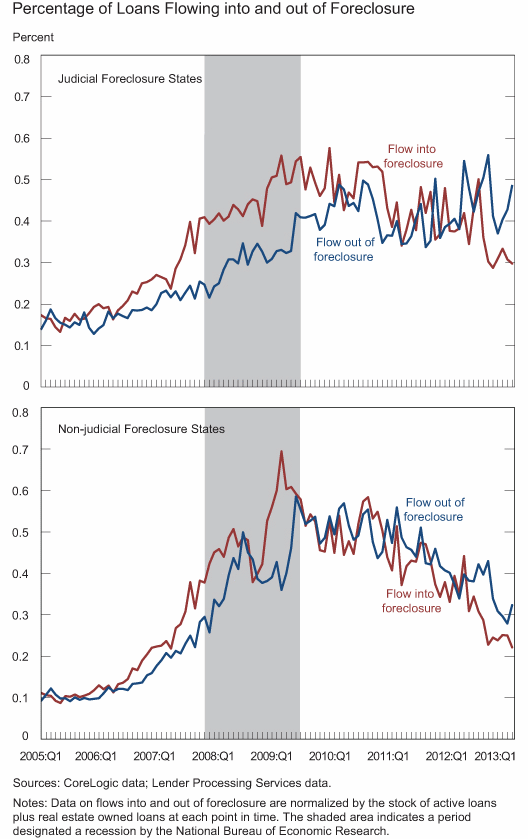The Federal Reserve Bank of New York has updated and released proceedings of a conference it held last October in conjunction with the Rockefeller Institute of New York. The conference, entitled Distressed Residential Real Estate: Dimensions, Impacts, and Remedies was devoted to three main topics:
-
An assessment volumes of properties that remained in foreclosure and in the real estate owned (REO) pipeline on a state, local, and national basis.
-
Research on the impact of foreclosures and distressed sales on home prices, ownership rates, communities and families, and state and local government finances.
-
Policy initiatives intended to reduce the number of foreclosures and their associated impacts.
At the conference national and state level data as of June 2012 was provided by CoreLogic. Categories included the number of properties which were 90-plus days delinquent, in foreclosure, and in REO, as well as alternative projections of future REO inventories based on the number of days a loan stays in a ninety-plus day bucket and the average days in foreclosure.
That information, now updated to March 2013, shows just under 3 percent of all mortgaged one-to-four-unit residential properties were ninety or more days delinquent, essentially unchanged from June 2012. This is below the peak of about 5½ percent reached in late 2009 to early 2010, but well above the pre-crisis average of just under 1 percent.

In contrast, the percentage of loans in
foreclosure, which had leveled off at around 4 percent from
early 2011 through mid- 2012, declined to around 3½ percent by
early 2013 because, for the previous nine months more loans had moved
out of foreclosure than moved in. Finally, the percentage of
properties in REO continued to decline gradually over the period from
mid-2012 to early 2013.
The conference looked at the large
disparity in performance between states with a judicial foreclosure
process and those with a non-judicial process and noted that the
average number of days that a mortgage loan is ninety-plus days
delinquent at the time the foreclosure process is started is roughly
comparable in judicial and non-judicial states and that the
percentage of loans flowing into foreclosure is also around the same.
The key distinction is in the rate of flow out of foreclosure or,
alternatively, the average number of days a loan/property remains in
the foreclosure process.

The difference between the judicial and non-judicial states is seen more clearly in the following scatter plot. The horizontal axis measures a state's ninety-plus-day delinquency rate in the first quarter of 2010 when that rate peaked nationally. The vertical axis measures a state's foreclosure rate in the first quarter of 2013. The blue diamonds represent non-judicial and usually non-judicial states while the red squares represent the judicial and usually judicial states. The corresponding blue and red lines are least squares regression results for the respective sets of observations. For a given level of the ninety-plus-day delinquency rate in the first quarter of 2010, the judicial states have considerably higher foreclosure rates in early 2013, indicating that the length of time a loan/property remains in the foreclosure process in the judicial states is considerably longer than in the non-judicial states. New York, New Jersey, and Florida stand out as the most extreme examples of this phenomenon.

The considerably
larger volume of loans in the foreclosure process in the judicial
states appears to be impeding home price recovery in those states.
As can be seen in the chart below, for a given peak-to-trough decline
in home prices, the judicial foreclosure states have seen a
meaningfully more modest improvement in home prices since the trough.
(The exception is North Dakota, a small state with unusual
demographics related to its current energy boom.) One potential
explanation for this relationship is that potential homebuyers in the
judicial states recognize that a large number of distressed sales
have yet to occur, and this consideration has influenced the prices
they are willing to offer for homes currently on the market.
Conference participants concluded that non-judicial states are much further along in reducing the backlog of loans in foreclosure and that have prices have recovered more in the non-judicial states.







